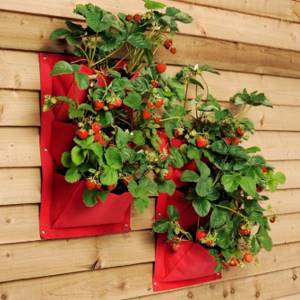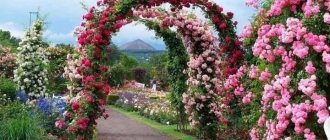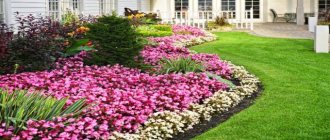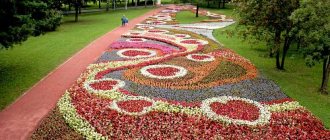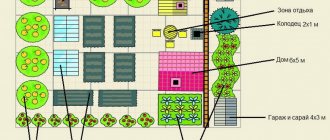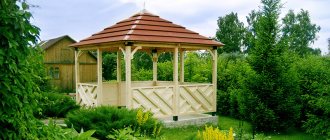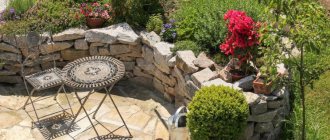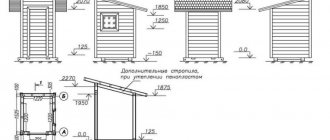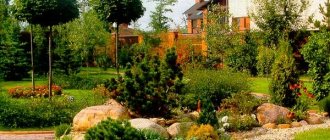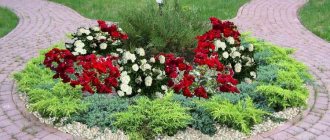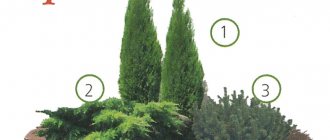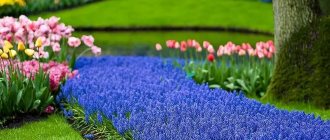Garden decor
Having your own garden with beautiful flowers is the dream of romantic gardeners who want their territory to be bright and attractive. But chaotic planting of plants is not always appropriate, and if the site is also limited in space, you need to think about how to properly arrange the flower garden. Do-it-yourself vertical flower beds would be an excellent solution. The production of such structures will not take much time, and a large variation of shapes and materials allows you to choose the most suitable option. We propose to consider several interesting and simple ways to create such flower beds.
- 1 Vertical flower beds and flower beds with your own hands: advantages of the solution
- 2 Original do-it-yourself vertical flowerbed made from mesh
- 3 Practical DIY vertical flower bed made from a pipe
- 4 Simple vertical flower bed from pots
- 5 Other options for creating vertical flower beds with your own hands from available materials 5.1 Turning plastic bottles into flower beds
- 5.2 Use of old pallets
- 5.3 Vertical flower beds made from building blocks
Landscaping: necessity and benefits
Like additional decor, a beautiful flower bed plays an aesthetic and practical role, decorates the site and attracts pollinating insects.
Using flower beds, you can carry out practical and objective zoning of the territory, highlighting the garden and recreation area with bright accents, defining and setting the boundaries of free and occupied areas for useful plantings.
Large and spacious flower beds require careful and careful care, time and money to maintain their attractiveness.
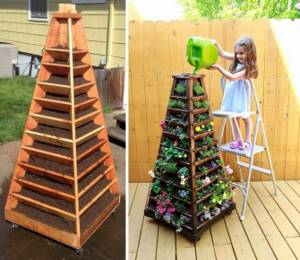
Landscape design specialists offer various options and solutions for arranging a site in a modern style, using new designs and original, unusual flowerbed designs.
Basic rules for arranging flower beds and their types
Extensive flower beds provide a riot of colors and a variety of options for applying landscaping principles that help decorate the area.
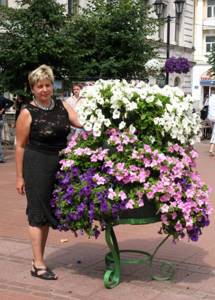
To arrange the local area with green spaces and flower beds, it is recommended to use the following rules to help complement the landscape design concept:
- the preparation of flower beds is carried out in early spring, for which the site should be properly zoned;
- when choosing plants and flowers, you should take into account the period of their active growth and maximum flowering;
- for green flower beds and plantings, you should select varieties of flowers that grow well in these climatic conditions;
- When planting several types of plants, it is important to take into account the sequence of their flowering, which will increase the attractiveness of the flower bed.
When choosing plants and a place for arranging a flower bed or several flower beds, it is important to correctly distribute the free and occupied space of the site.
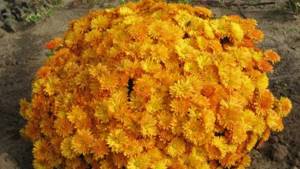
Spectacular compositions of flowers and green plants, replacing each other during periods of active growth, help maintain a stylish and attractive appearance of the site.
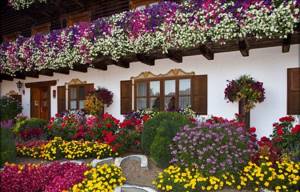
Ideas
To independently create vertical flower beds to decorate the walls of a private house, you can use many available materials: pipes, mesh or pots. How to make a flower garden and what appearance it will have will depend on what materials will be used for planting flowers.
Plastic bottles
The most accessible and cheapest option for installing a hanging vertical flower bed is to use old plastic bottles. To do this, you need to take a sufficient number of bottles, cut off the bottom of each of them and slightly unscrew the caps to drain excess moisture. Next, holes are made in the upper part of the plastic pots for attaching to the wall, after which they are filled with prepared soil. When the pot is ready, seedlings can be planted in it.
After planting the plants, the bottles are fixed to the wall or any vertical plane. If done correctly, the plants will grow quickly enough to cover the unattractive front of the plastic and the wall around it with their color.
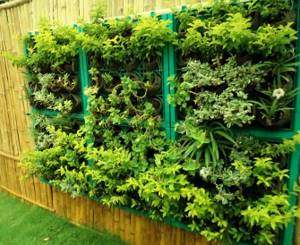
PVC pipes
Large diameter polyethylene pipes are ideal for installing compact vertical flower beds and flower beds near the wall. Large holes are drilled into them for the root system of plants, then the pipe is dug vertically into the ground, filled with prepared soil and baking powder so that the soil does not cake and the root system of plants does not suffer. Plants can be planted in the drilled holes of the flower bed. Watering the flower bed is done from above, into the pipe.
Many gardeners use pipes to grow strawberries, strawberries and other creeping berry bushes.
The second way to install vertical flower beds made of plastic pipes is to place them on a vertical tripod. To do this, holes of the required diameter are drilled in the pipe on one side, and the pipe is laid on a triangular base made of wood or hung on the wall with small hooks and wire.
Boxes, pallets, containers
Wide boxes, pallets or containers stacked on top of each other in a cascading pyramid are ideal for installing a high stepped flower bed on a wood or metal frame. Pyramid structures with flower seedlings or strawberry bushes also look great as an independent design element next to a private house.
Boxes for flower beds must be filled with stones for drainage and special baking powder so that the soil in the flower garden does not cake when watering.
Pots, watering cans, buckets
To diversify the appearance of a flower bed and give an original look to the landscape design on a site with a private house, you can use flower pots, watering cans, and decorated plastic or metal buckets.
Small buckets with flower seedlings in a flower bed or on a wall, or old beautifully decorated watering cans in a flower garden will create a rustic atmosphere on the site.
The shape of the flowerbed will be given by the frame and the order in which its individual elements are placed on it.
Mesh and geotextiles
You can build a vertical cylindrical flower bed using mesh and geotextiles. To do this, you need to twist a metal mesh and secure it with wire, dig it into the ground, and wrap geotextiles around it with holes cut in the front. Soil is poured inside the flowerbed and plants are planted into the vertical flower bed through the previously made holes.
Such a system requires more frequent watering, since the walls of the flowerbed will quickly evaporate water. The flower garden needs watering daily.
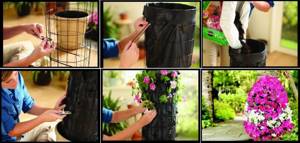
Other options
You can create vertical flower beds and flower beds not only from pipes, but also from other available materials. For example, flower beds made from old car tires, thick bags or barrels are popular.
Flower beds and cascading compositions made from a variety of available materials allow you to grow not only petunia flowers and berries, but also salad greens. Placing vertical flower beds with nasturtiums or petunias on the wall of the house will be a real boon for decorating and disguising the uneven wall of a private house, and flower beds and flower beds can be placed in any free space on the site.
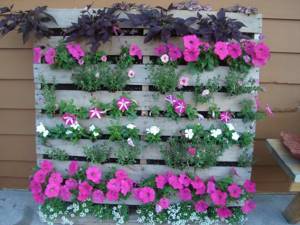
Vertical flower beds: general description and characteristics
An important feature of vertical flower beds is their location, while the owners of the plot retain all the advantages of horizontal structures.
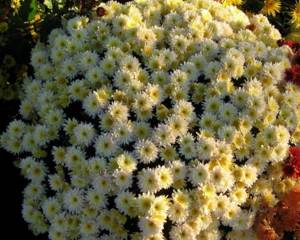
Such solutions have certain characteristics that act as advantages and general characteristics, which allows you to make a choice in favor of such flower beds:
- elongated flower beds can differ in different shapes and configurations, be voluminous and flat;
- For such structures, familiar plants and flowers, upright and climbing, succulents and lawn grass are suitable;
- The use of vertical flower beds helps to save free space in front of the house or country house.

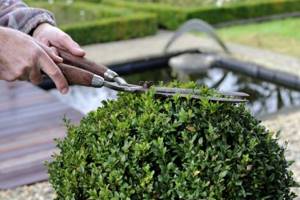
Evergreens - a complete list with descriptions and recommendations from a gardener- Vertical gardening - from idea to implementation, choosing options according to budget and attractiveness (photo + video)
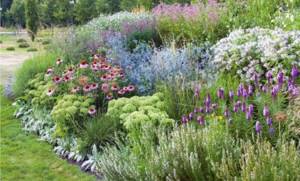
Decorative grass - 140 photos of original design. Review of the best varieties of grass for the garden, instructions, reviews, videos + gardener recommendations
Various ideas and unique solutions for making a vertical flower bed are simple technologies that do not require large financial investments for implementation.

Thrifty owners can use purchased ready-made structures or improvised materials, which helps reduce the cost of the project and will help give such a flowerbed a special originality.
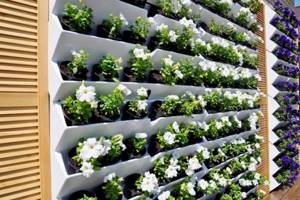
Bushy
The ideal filling for a vertical flower bed would be plants of medium height. Species that tend to grow are preferred. The choice often comes down to the following options:
- petunia;
- matthiol;
- lobelia.
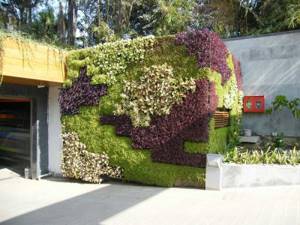
You can also pay attention to clematis. Creating a fluffy “hat” will require attention.
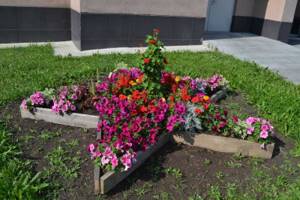
Making a vertical flower bed on your site is a good solution. The flower garden will save space, giving a good decorative effect. This option is especially relevant for those who are tired of “cliches” and strive for diversity in the design of the territory.
Types of vertical flower beds and ideas for their arrangement
In order for a vertical flower bed made by yourself to become a real decoration for the site, you should choose a unique idea for its arrangement in advance.
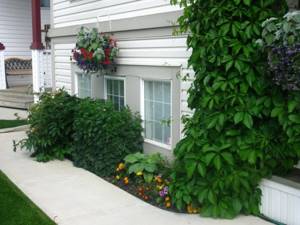
It will not be difficult for home craftsmen to build the simplest structure, which can be part of an outbuilding or fencing structure, or installed separately.
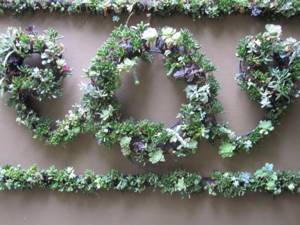
For work, you may need not only available materials, but also additional accessories, tools and devices.
- Watering the site - types and types of systems, main differences and features, rules for selection and installation, as well as recommendations for operation
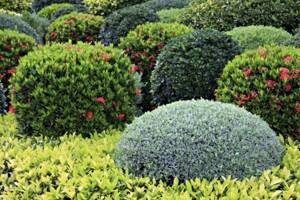
Ornamental plants - 140 photo options. Review of the most popular plants with names and descriptions. Gardener's recommendations + reviews
- Boxwood: planting, care, growing in open ground, propagation. Full description of the plant from A to Z. More than 100 photos of evergreen shrubs
Special attention should be paid to the selection of seed material that will be needed for landscaping the site and the final decoration of finished structures of vertical flower beds and flower beds.
Creating hanging vertical flower beds
For hanging flower beds, in most cases, a very reliable support is required that will be able to withstand the weight of the structure itself, the soil and growing plants. If there is no such support, you can create something like a cone-shaped column in a flowerpot by planting several climbing plants. The lower the pot is lowered, the higher the “flowerbed” will turn out. Recently, entire “hanging” vegetable gardens have become widespread. Using their principle, you can create a flower garden. For this purpose, special containers are now sold, ready for planting. But since we are decorating the garden plot with our own hands, we will build them ourselves. The easiest way is to take a plastic barrel and prepare it in the same way as for the above-ground option described above. The main thing is to securely and correctly fasten it to the support, since the entire structure will have considerable weight. Instead of a barrel, you can make a frame from a metal mesh, roll it into a cylinder or cone, secure it with wire, tuck a large thick garbage bag into it, make holes in it and plant plants in them. This flowerbed can be hung or placed on the ground in a large flowerpot.
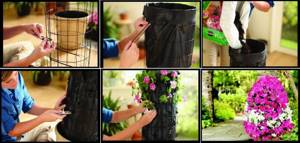
If we talk about universal options that are suitable for all types of vertical flower beds, we should not forget about plastic bottles. This is where their practicality will be most in demand. Firstly, they are very light and small, so they can be attached to almost any support. Secondly, you can create a container of any configuration from them by cutting a hole or cutting off an unnecessary part. If you leave only the lower half, you can insert such pots into a specially prepared trellis. If you make a side hole, you can simply hang them on the fence in any quantity, vertically or horizontally, creating a wide variety of compositions.
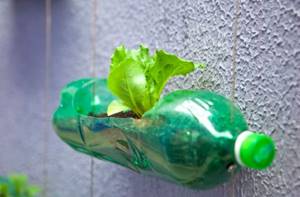
Plastic bottles with the bottom cut off can be connected to each other, fastened with wire or glue and forming various shapes. Then fill them with soil and plant flowers. You can get very unusual flower beds of absolutely any shape.
Purchased containers
In specialized country stores and large supermarkets you can purchase hinged and attached containers and full-fledged modular structures.
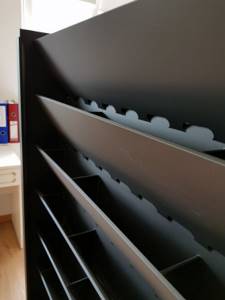
Special containers are made of wear-resistant materials and are intended for the construction of vertical flower beds of different configurations.
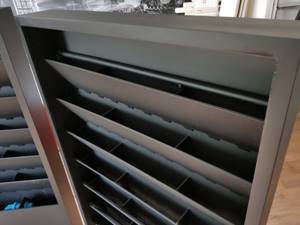
Green screen
Boring and monumental fencing structures can be turned into an original green screen using simple and affordable materials.
Various containers are fixed on a sheer wall; for this you can use long and narrow wooden boxes, flower slides or tea cups, cut plastic bottles.
flower tower
The narrow and upward-pointing structure will become an original decoration of any territory, and can be a real flowering tower or pillar.
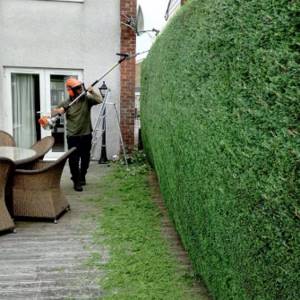
Living fence - the best ideas on what to make a hedge from at your summer cottage. Many photos of ready-made options with exclusive designs + instructions- Trimming bushes - the basics of choosing the right plants and forming the right shapes, selecting tools (photo + video)
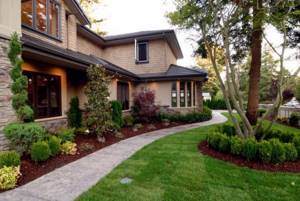
Landscaping a site - basic principles and rules for creating a beautiful site with your own hands
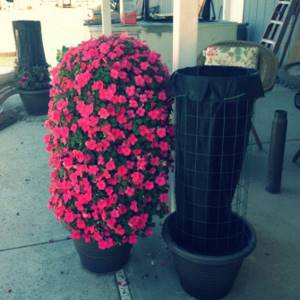
To build a tower, a support with containers attached to it or a plastic pipe with a certain radius and drilled holes, or a post made of chain-link mesh are used.

Plants for vertical gardening inside the house
Vertical gardens, also called phytowalls, are becoming increasingly popular. Many famous designers add phytowalls to their projects. The vertical garden in the apartment has an attractive appearance. Even frescoes or the most expensive wallpaper cannot compare with the appearance of phytowalls. A vertical garden will give any room an aesthetic appearance. Due to the fact that the vertical gardening system occupies a fairly large area of the wall of the room, it can be used to disguise some architectural defects, uneven walls or areas of communications.
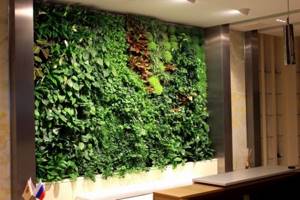
When decorating phytowalls, as a rule, small-sized plants are used. Creating vertical compositions on the wall of a room requires a complete flight of imagination. But special attention should be paid to those plants that are able to retain their shape well.
Arrowroot is a plant belonging to the arrowroot family. It is a low, pretty plant. In the evening, its leaves take a vertical position. Because of this feature, arrowroot is often called a “prayer plant.” Arrowroot is ideal for creating phytowalls. For good growth, the plant needs moderate air temperatures, no direct sunlight or drafts, and regular watering.
Ctenante is a plant similar in appearance to arrowroot, but under favorable conditions it can grow up to a meter in height. Has a spectacular appearance. Cover the surface of large leaves with cream-colored spots. The plant is quite finicky to care for.
Perfect for planting on phytowalls and calathea. This plant also belongs to the arrowroot family, so the growth conditions of this plant are practically no different from the growth conditions of arrowroot. The surface of the leaves, which are located on long petioles, have a beautiful pattern. The leaves have a characteristic shape for different varieties. The shape can be elongated, narrow or oblong.
Related article: Do-it-yourself suspended plasterboard ceiling with lighting: step-by-step diagram (photo, video)
Suitable for planting on a photo wall is the compact and low stromanta. Stromantha leaves have an elongated shape with a glossy surface and variegated color. The lower surface of the leaves is burgundy in color. For normal growth, this plant requires a large amount of diffused lighting, high air humidity and warmth.
Ivy is one of the most popular indoor plants, which is used to create vertical landscaping in a room. Ivy is often called climbing plants that have nothing in common with this plant. The appearance of ivy is quite varied. The leaves of this plant can vary in size, color and shape. You can plant ivy either on an entire wall or a separate phyto-picture, or use it as an addition to other plants.
Scindapsus can also be used for vertical gardening. This is a liana. Usually it is grown on a support or in a hanging form. The leaves of scindapsus have an unusual variegated color and are quite large in size. This plant propagates well by cuttings, and in order to increase branching, it is often pinched.
Another plant of the aroid family is syngoninum. It is often grown using support. Arrow-shaped leaves look very interesting in vertical gardening compositions. Due to the rapid growth of syngoninum, the phytowall can be given a rather decorative appearance in a short time.
For vertical gardening, you can use such an unpretentious and hardy flower as chlorophytum. Lush islands of rosettes of narrow variegated leaves create the impression of an abundance of greenery. The elegant appearance of this plant is given by white stripes in the centers or on the sides of long leaves.
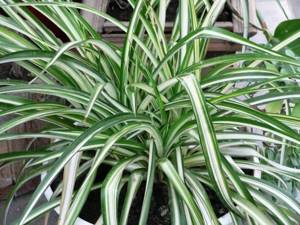
Tunnel of flowers
If there is sufficient free space on the site, you can build a full-fledged green tunnel from flowers and greenery.
Such tunnels perfectly replace tents or open gazebos, canopies of various types, creating cozy coolness and protecting from scorching heat, and for them it is better to choose plants that are accustomed to the heat.
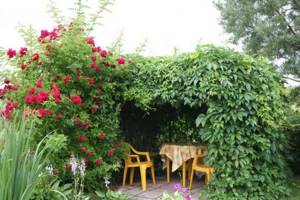
Caring for beds in bags
In general, the principle of caring for beds in bags is not much different from caring for a classic vegetable garden. However, there are also some nuances.
- Firstly, it is advisable to install the bags on stands made of bricks or stones to protect the beds from pests and weeds. This will also make them easier to transport - the bag will be easier to grab with your hands and lift.
- Secondly, it is recommended to support the bags with vertical supports so that the beds do not spread or tip over.
- Thirdly , we repeat once again, vertical beds require more frequent watering. Please note that water must be poured strictly into the drainage column, otherwise the plant roots may rot due to excess moisture.
Vegetable garden beds are not afraid of underground pests
As you can see, you can grow vegetables and herbs even in a small area with not the most fertile soil. The main thing is to know how to do this effectively.
Balls of flowers
The use of volumetric structures remains quite relevant for the arrangement, decoration, and landscaping of local areas.
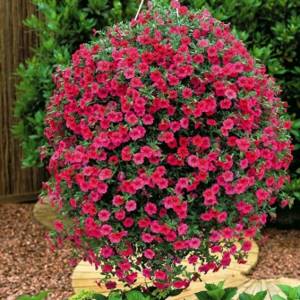
A welded ball made of metal structures or formed from wire is installed on a certain support; a polymer bag with soil and planted seeds of climbing flowers is placed in it.

Round hanging flowerbed
A flowerbed-ball with petunias growing in it looks very chic, and you can make it yourself using wire with large cells. To do this, you need to form a frame ball of the desired volume from the wire (if desired, the base of the flower bed can be twisted into a cylinder shape). Line the inside of the ball with film and cover it with nutritious soil on top. To be able to water in the center of the flowerbed, insert a small pipe so that it is flush with the frame.
Make several drainage holes at the bottom of the hanging flower bed to allow excess water to drain.
The flowerbed is ready, all that remains is to plant the petunias: cut the film in the center of each cell, deepen the soil and plant the seedlings in the hole. You can hang such a flowerbed using a chain.
Decorative umbrellas
It’s very easy to create beautiful and original vertical flower beds with your own hands from scrap materials; just choose the idea you like.
A metal structure in the form of an umbrella, installed on a pipe filled with soil, will be covered with a green and bright carpet during the period of plant growth and flowering, fully simulating the appearance of a protective accessory.

Practical DIY vertical flower bed made from a pipe
Most often, structures made from PVC pipes are used for planting strawberries. Such a vertical do-it-yourself strawberry flower bed not only has a presentable appearance, but also guarantees ease of care for the berries. But it is not necessary to plant wild strawberries there; you can use the structure for petunias, nasturtiums, and other hanging plants.
To create such a flower garden, prepare two PVC pipes of different diameters. It is optimal to use 5 and 15 cm. A smaller pipe will be needed for watering plantings; its length should be slightly longer than the main structure.
This video shows the process of creating a vertical bed for strawberries
Step-by-step guide on how to make a vertical flowerbed with your own hands:
- Holes are made in a pipe with a smaller diameter through which water will flow out. To prevent blockages, wrap the perimeter of the structure with burlap or non-woven material and secure it tightly.
- The bottom of the pipe from which watering will be carried out must be covered with foil or a thick layer of tape.
- Holes are made on the outer pipe, the distance between them is 20-25 cm. There is also a plug at the bottom. The outer pipe is firmly fixed in the vertical direction, then a structure is installed inside through which watering will be carried out.
- In the formed gap, a layer of expanded clay or gravel is first laid, and then soil is laid.
You can also create a vertical flower bed in another way without drilling holes in the pipe
To prevent voids from forming, water the flower bed for a couple of days. This will allow the earth to settle and, if necessary, the container can be replenished with soil. Then start planting the plants in the containers you made.
How can you decorate vertical flower beds on your site?
You can uniquely design a flower bed by using different plants and flowers, additional decorations and decor.
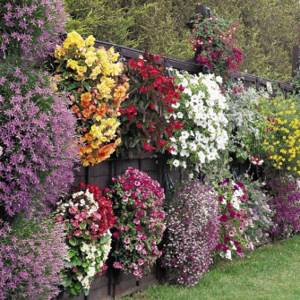
When choosing planting material, it is recommended to take into account several parameters that will help maintain the external and aesthetic appeal of the finished structure throughout its service life:
- period of growth and flowering of selected plants;
- required conditions and agricultural techniques for caring for flowers;
- external climatic and weather conditions.
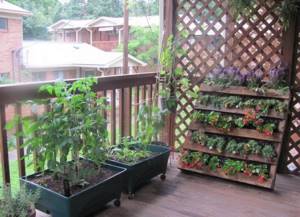
The most original and interesting decoration of a vertical flower bed remains greenery and flowers, which will transform the entire area before construction.
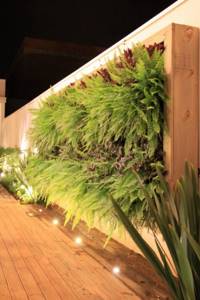
With the correct selection of planting material, any type of flower garden will bloom throughout the warm season, and in winter it will delight you with rich green flowers.
Option number 9. Vertical flower bed made from old furniture
If you have old unnecessary furniture on your site (a chest of drawers, for example, or a table), then you can also use it to decorate your site. For example, an old table with drawers. To put it in order and maximize its service life, treat all surfaces with an antiseptic, and slightly pull out the drawers and fix them in this position. You use them as flower beds.
All that remains is to fill the substrate there and plant flowers or herbs. As a result, you will not only improve your “possession”, but also give old furniture a second wind.
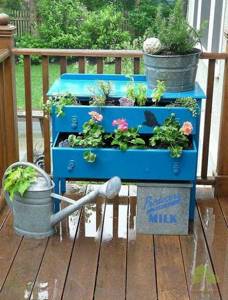
Evergreens
Succulents and evergreens envelop the entire territory allocated to them with an original carpet, limited only by the structural features of the flowerbed.
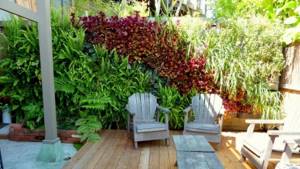
Such plants are great for decorating the local area during the cool season, and these flower beds can be decorated for the New Year holidays using garlands and lighting.
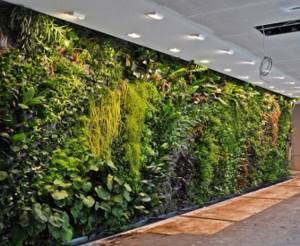
climbing flowers
Traditional petunias for vertical flower beds can be replaced or combined with other plants that produce climbing shoots and stems.
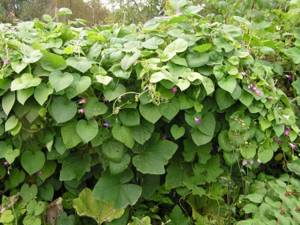
Thanks to this property, the flowerbed will be decorated not only with bright and beautiful flowers, but also covered with lush greenery, noticeable from afar, which makes it possible to increase the decorativeness and aesthetics of the area and landscape.
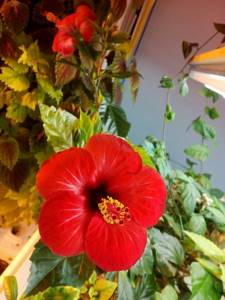
Strawberries and greens
Habitual flower beds for strawberries or wild strawberries can be successfully replaced with unusual vertical-type structures, with the possibility of saving free space.
To obtain a rich harvest of tasty and healthy berries or herbs used in cooking, you can use flower beds of different types and designs.
